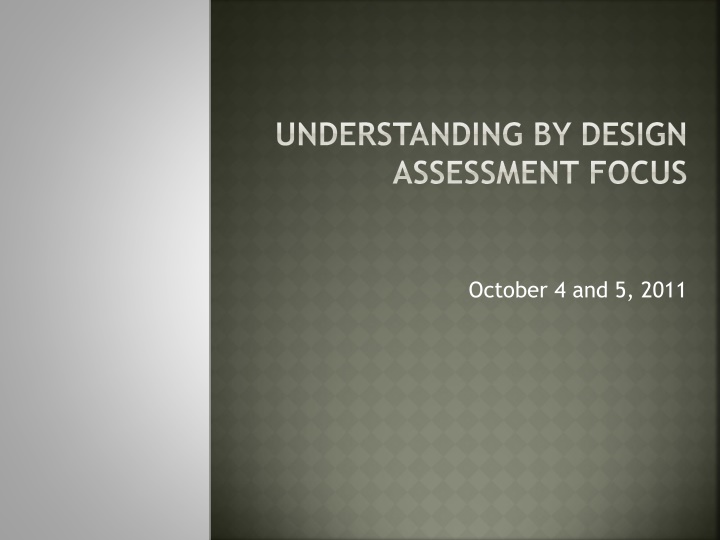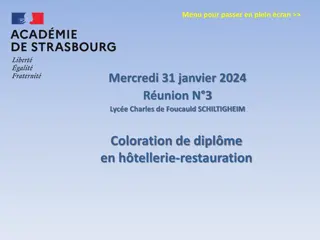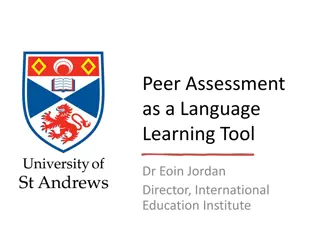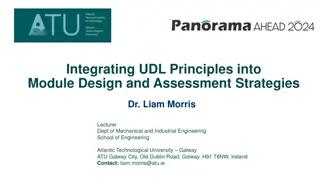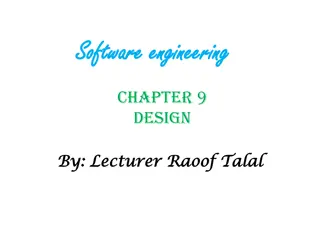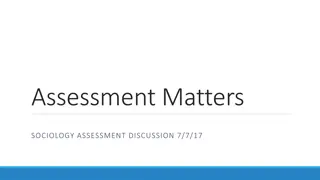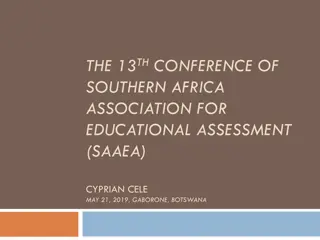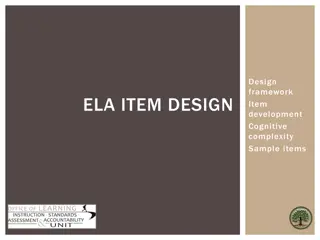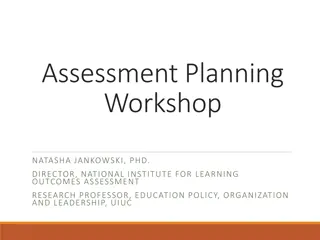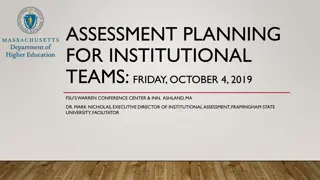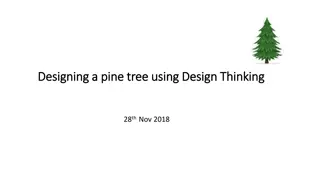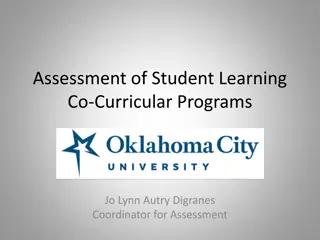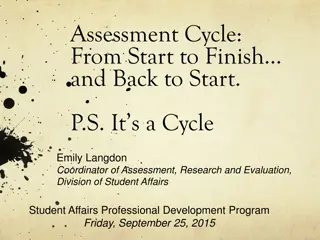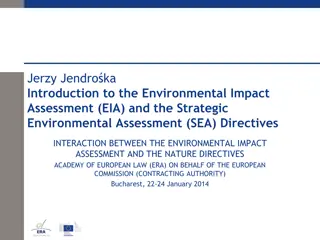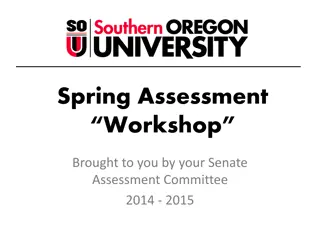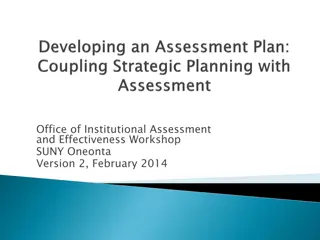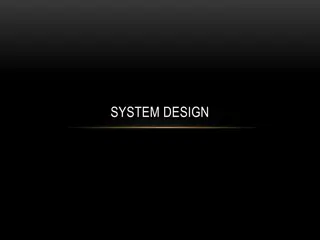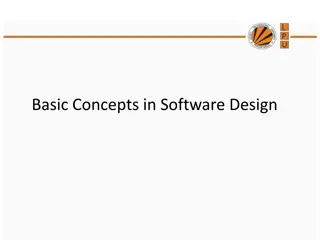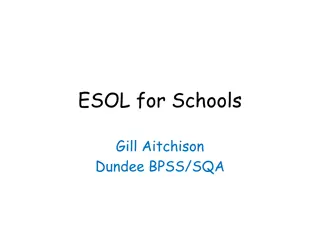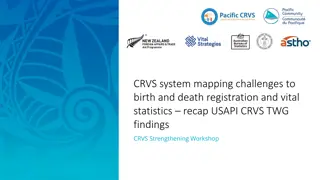Enhancing Understanding through Assessment in Educational Design Workshop
Learn and collaborate on assessment practices in education design at the "Understanding by Design Assessment Focus" workshop. The agenda includes sessions on summative and formative assessment, feedback, reporting, and more. Engage in activities like generating questions, finding destination partners, and discussing authentic assessment. Sharpen your assessment skills to align with updated curricula.
Download Presentation

Please find below an Image/Link to download the presentation.
The content on the website is provided AS IS for your information and personal use only. It may not be sold, licensed, or shared on other websites without obtaining consent from the author.If you encounter any issues during the download, it is possible that the publisher has removed the file from their server.
You are allowed to download the files provided on this website for personal or commercial use, subject to the condition that they are used lawfully. All files are the property of their respective owners.
The content on the website is provided AS IS for your information and personal use only. It may not be sold, licensed, or shared on other websites without obtaining consent from the author.
E N D
Presentation Transcript
UNDERSTANDING BY DESIGN ASSESSMENT FOCUS October 4 and 5, 2011
GETTING STARTED What is our purpose and where are we going?
PURPOSE To refine our understanding of assessment in all its forms and consider its link to renewed curricula. To provide time to reflect and collaborate with others. To continue to work through the UbD process.
AGENDA 9:00 9:30 Assessment in the NESD 9:30 12:00 Summative assessment (Criteria and rubrics) 1:00 2:00 Formative assessment and feedback 2:00 2:45 Reporting 2:45 - 3:00 Final Go Round
GENERATING PARKING LOT QUESTIONS Line up according to birthdates. In your group, generate questions you have about formative assessment, feedback, summative assessment and reporting. Be prepared to share questions.
DESTINATION PARTNERS Find your destination partner sheet Sign up four different people for your four different pairings
ASSESSMENT IN THE NESD How do we define assessment and what tools should we use?
Find your Hawaii partner. Consider: What is authentic assessment? Why do we assess? What do we assess?
AUTHENTIC ASSESSMENT Authentic assessment clearly assesses the outcomes in a context that reflects the actual learning experience. In other words, we assess in the exact same way we have invited students to learn. Authentic assessment also invites us to ask how students may come to apply the knowledge and skills they have gained and assess them based on that information.
ASSESSMENT PLAN An assessment plan clarifies the learning destinations through establishing criteria. It clarifies how evidence of learning will be collected through products, observations and conversations. An assessment plan is realized over the course of an entire unit and, ultimately, over the course of a year. It aims to provide multiple opportunities for students to demonstrate their learning. It clarifies how students will be assessed formatively and summatively, how they will be offered feedback and how their progress will be reported.
IN THE NORTH EAST SCHOOL DIVISION WE BELIEVE: Effective instruction depends on high quality assessment. Each assessment must reflect learning outcomes and standards of quality understood by all staff members. The primary purpose of assessment is to improve student learning. Therefore, we expect all assessments to provide accurate and timely information about student achievement. It is the expectation of the NESD that all assessments will be directly linked to specific student learning outcomes, use assessment methodology appropriate for the subject/grade level, and allow for effective and frequent communication of results. Assessment can serve as a powerful form of instruction. By involving students in the assessment of their own achievement under direct supervision, teachers can use assessment and feedback to ensure students progress towards meeting the expected learning outcomes for each subject, at each grade level. A variety of assessment events based on consistent, outcome-based assessment tools are considered appropriate within the NESD. Any progress report should result from varied assessment events, using criterion-established tools (rubrics). A differentiated approach allows all students to be assessed on the same student learner outcomes in a manner appropriate to each individual. Achievement and behavior should be assessed and reported separately. The purpose of this practice is to enhance and clarify information shared with others in order to make informed decisions about how learning will move forward
TWO APPROACHES TO THINKING ABOUT ASSESSMENT When thinking like an assessor, we ask When thinking like an activity (only) designer, we ask What would be sufficient and revealing evidence of understanding? What are the different types of evidence I can use to assess student learning? Against what criteria will I consider work and assess quality? Did the assessments reveal and distinguish those who really understood from those who only seemed to? Do I know why mistakes were made? What would be fun and interesting activities on this topic? What projects might students want to do? What tests should I give based on the content I taught? How will I give students a mark and justify it to their parents? How well did the activities work? How did students do on the test? Wiggins and McTighe (2005)
WHAT IS ASSESSMENT? Assessment for Learning Assessment as Learning Formative Assessment of Learning Summative
ASSESSMENT FOR LEARNING Gather as much data as possible about what students know and can do in order to understand where the learning gaps may be. Using assessment tools (such as rubrics) to make instructional and learning decisions. Using assessment to plan for future learning (pre-assessments, formative assessments)
ASSESSMENT AS LEARNING Coming to know the criteria by which learning will be measured so students come to recognize their own growth and opportunities for further learning. Using assessment tools (such as rubrics) to clarify the learning destination before and during learning. Using assessment to increase learning.
ASSESSMENT OF LEARNING Strategies designed to confirm the degree to which students have met curriculum outcomes or the goals of their individualized programs. Assessment of learning is the assessment that becomes public and results in statements or symbols about how well students are learning
So how does assessment fit into Understanding by Design?
PROCESS STAGE TWO OF THE PLANNING Once outcomes are understood in their complexity and intent, it is time to consider how to assess learning both formatively and summatively. It is time to clarify the learning destination (criteria). Critical Evidence of LearningTwo Critical Evidence of Understanding Formative Assessment Through what multiple sources of evidence will students demonstrate their understanding on a daily basis. Summative Assessment Is an assessment of what students know and can do according to the outcomes. It is a snapshot in time, used for reporting.
SUMMATIVE ASSESSMENT
RUBRICS What are they really supposed to do for me and my students?
LOOKING AT RUBRICS Find your Argentina partner and look at the rubric samples provided for your subject area. Consider: What task are these rubrics assessing? What values do these rubrics communicate? What do they say is most important about this task?
STICKY NOTE BRAINSTORM 5 MINUTES Using the same rubrics, write down your observations, comments or questions about the rubrics provided. Put one idea/ sticky note.
SHARING 10 MINUTES Join with another pair. Share your sticky notes with each other. Sort sticky notes into general categories of commentary/ questions.
HERES WHAT/ SO WHAT/ NOW WHAT 10 MINUTES Choose three and use the following prompts to reflect: 1) Here s what we notice 2) So what does this say about rubrics/assessment/ learning, etc.? 3) Now what we propose is Be prepared to share 5 minutes
REMEMBER: Understanding is not yes or no; it is a matter of degree. It is a continuum!
CRITERIA Ask yourself: What will students need to do in order to demonstrate the knowledge and skills required in this outcome?
PERFORMANCE STANDARDS How will I know how far and deep they need to travel in their understanding? What is the continuum of learning for this outcome? What will it look like? How can I help myself and others come to understand how learning progresses?
USC 5.1 ANALYZE PERSONAL EATING PRACTICES. Exceeding expectations Meeting expectations independently Mostly meeting expectations with assistance Not yet meeting expectations, even with assistance Analyze personal eating practices You show a strong and in depth understanding of your personal eating practices and can make strong connections between how, what and when you eat and your overall health. On your own, you show you can recognize the kinds of food you eat, when you eat and why you eat the way you do. You can back up your ideas with details and examples and your explanation and reasoning is clear. With help, you can somewhat identify your personal eating practices and give some details to support your ideas. Spend some more time thinking specifically about what, how and when you eat and how it affects your health. You are having trouble showing you understand your own eating practices and how they affect your health. What does it mean to eat healthily? How can you keep track of your own eating? How are the two things connected? Key verb Analyze, which means examining relationships, making connections and supporting ideas with examples, details and explanations.
SS 4.4 DEMONSTRATE AN UNDERSTANDING OF LINE SYMMETRY BY: IDENTIFYING SYMMETRICAL 2-D SHAPES CREATING SYMMETRICAL 2-D SHAPES DRAWING ONE OR MORE LINES OF SYMMETRY IN A 2-D SHAPE Great work! This is going extra well for you! You did it and you did it on your own! Good start. You are beginning to make sense of this on your own. With some reminders, you could identify basic symmetrical 2-D shapes. Work on describing the characteristics of symmetrical shapes and explaining why this relates to your ability to sort them. With some help, you can create basic symmetrical 2-D shapes. Try making shapes that are a little more challenging. Try different methods for making shapes. You can do it. Spend some extra time with the criteria and ask for help. You are having trouble identifying symmetrical 2-D shapes. Review what symmetrical means. Try finding shapes by folding paper and using a mirror. Identify symmetrical 2-D shapes You consistently and confidently could identify the characteristics of both simple and complex symmetrical and non-symmetrical shapes in many different contexts (given and environmental), sort the shapes and thoroughly explain your reasoning. On your own, you could identify the characteristics of given symmetrical and non-symmetrical shapes and sort shapes into symmetrical and non-symmetrical, explaining your reasoning. Create symmetrical 2-D shapes You can confidently and consistently create symmetrical 2- D shapes in many different contexts, with shapes of increasing complexity. You can also explain how symmetry and fractions are related. You clearly understand symmetry. You can consistently and accurately draw one or more lines of symmetry in 2-D shapes of varied difficulty. You clearly understand lines of symmetry and the role they play in symmetrical shapes. On your own, you can create symmetrical 2-D shapes by completing shapes that have been started, identifying lines of symmetry and using manipulatives. You are having trouble creating symmetrical 2-D shapes. Start with shapes that are already symmetrical where is the line of symmetry? Try using a Mira or folding to get the hang of it. You are having trouble understanding the concept of lines of symmetry. Take 2-D shapes and practice folding them to find lines of symmetry. Ask for help. Draw one or more lines of symmetry in a 2-D shape On your own, you can draw one or more lines of symmetry in a given 2-D shape.How do lines of symmetry related to symmetrical shapes? With some guidance, you can sort sets of 2-D shapes into those with no, one or more than one line of symmetry. Now practice drawing lines of symmetry on 2-D shapes.
RUBRICS Clarify the learning destination before day-to-day planning occurs through establishing criteria. Help students to see exactly where the learning is headed. Can be used formatively as well as summatively. Articulate how learning can continue.
RUBRIC DESIGN If possible, gather samples (written, video, photos, etc.) of student work Use samples to clarify performance standards Start discussions with the level you want all students to reach (ex. a 3 on a 4 point rubric) Avoid numbers in performance indicators (ex. Is able to list three out of four ) Keep descriptors positive - For example Needs editing instead of Many mistakes. The first descriptor tells a student how to improve. Numbers on rubrics are challenging because some students track for just enough instead of for success. Avoid including criteria that measure adherence to directions of a task instead of mastery of the outcome (ex. Included title).
Continue with your Argentina partner. Referring to your UbD plans/ unpacked outcomes and curricular documents, consider: Where do we get our criteria for assessment? Where do we get clarification about the degree to which levels of understanding or skill are required (descriptors or performance standards on a rubric, for example)?
USING CURRICULUM CORNER How do we use Curriculum Corner? How do we use rubrics already posted?
Look at a rubric for a subject you will be teaching and consider: What does this rubric tell us about how learning will look? How does it inform our teaching? How does it help students?
GROUP SHARE What did we come up with? How are our rubrics similar? How are they different?
PARKING LOT With your Argentina partner, look at the Parking Lot questions. Generate answers to as many questions as possible.
THAILAND PARTNER Consider: How does posting rubrics impact our practice? How can you imagine using rubrics in the learning process?
BENEFITS OF RUBRICS Students learn more quickly what it takes to produce high quality performances or products and what it takes to demonstrate deep understanding. Students develop the ability to self-assess well. Parents can gain insight into their children s strengths and the next step in their learning. Teachers have better information to guide the next steps in instruction. Teachers can give feedback to students that describes exactly what they are doing well and what they need to tackle next.
OUTCOMES TO CRITERIA TO LEARNING PLAN With your Thailand partner, consider: How does determining the criteria clarify the Learning Plan? How does the unpacked outcome help?
HEALTH 5 Unpacking the Outcome Analyze personal eating practices Outcome (circle the verb and underline the qualifiers) USC 5.1 Analyze personal eating practices. KNOW Nutritional values fat, sodium, sugars, vitamins Vocabulary beverage, promotions, food labels, calories, fats, sodium, vegetarianism, vegan, tradition, diet, diabetes, consume, serving, processed, portion, saturated, unsaturated Ways to know serving sizes (places to look) Appropriate and healthy food characteristics e.g. what a reasonable amount of fat is for a certain age group Kinds of changes a body undergoes in a lifetime and how diet may be related and impacted ESSENTIAL QUESTIONS How much can I depend on what I hear in ads and promotions? How do I know if I am getting all the information I need? How do companies use health as a way to promote their products? Why does it work? How do I know if I am eating healthily? How does the choices I make in eating affect my health and the way I eat? Why are processed foods different and how do they affect me? How will my eating practices change over time? How has society s eating changed over time? UNDERSTAND That promotional materials are design to get us to buy products and aren t always related to the healthiest options That one way to sway an audience is to cite health benefits That only by facing the reality of our eating practices can we truly make positive changes That certain diets require attention to getting the right nutritional components in alternate ways That processed foods contain elements that detract from health That changes that naturally occur in our bodies change what our body needs to care for it properly That society, as a whole, has changed its view toward eating over time BE ABLE TO DO Investigate info on food and beverages Examine info and promos to influence eating practices Explain importance of food labels (serving size, calories, nutritional info) Investigate variety of info on healthy eating (small meals, cultural foods and traditions, vegetarianism) Evaluate how certain diets require planning (cultural, vegetarian, diabetes) to ensure health Record and analyze personal food consumption for 5 days (servings, time, location) Observe and record factors that influence personal eating practices Examine own and others experiences with processed and non-processed foods and examine health benefits Examine how eating practices have changed over time Explain how changes in our bodies affect eating habits (growth spurts, exercise)
USC 5.1 ANALYZE PERSONAL EATING PRACTICES. Exceeding expectations Meeting expectations independently Mostly meeting expectations with assistance Not yet meeting expectations, even with assistance Analyze personal eating practices You show a strong and in depth understanding of your personal eating practices and can make strong connections between how, what and when you eat and your overall health. On your own, you show you can recognize the kinds of food you eat, when you eat and why you eat the way you do. You can back up your ideas with details and examples and your explanation and reasoning is clear. With help, you can somewhat identify your personal eating practices and give some details to support your ideas. Spend some more time thinking specifically about what, how and when you eat and how it affects your health. You are having trouble showing you understand your own eating practices and how they affect your health. What does it mean to eat healthily? How can you keep track of your own eating? How are the two things connected? Key verb Analyze, which means examining relationships, making connections and supporting ideas with examples, details and explanations.
Task #2 Goal: Comprehend & Respond: READING, listening Compose & Create: WRITING Assess & Reflect Essential Questions: What makes poetry fun to read? What are some of the features of poetry? Why is poetry a unique way to express you? 1.BEFORE: Use following questions as prompt for journal writing entry: a) How many times have you been asked, What do you want to be when you grow up? Make a list of ten possible answers-real or funny. b) Think of a poem or a rhyme that you can say off by heart. Write it down and explain why you remember it. c) What do you think about poetry? Explain why you feel the way you do. 2.DURING: Read, When I Grow Up for enjoyment. On second reading, identify message. (Reader response: Personal/Critical thinking) Read a third time and listen for rhyme scheme to identify pattern of rhyme (couplets). 3.AFTER: Discuss how rhyme pattern adds to the enjoyment of text and distinguishes the writing form. Consider how rhyme links to memory. Think of nursery rhymes you can say off by heart. Identify other features of poetry (expresses strong feelings/emotions; figurative language; concise, takes grammatical liberties to reflect message, can be humorous, etc.) 4.AFTER: Experiment with rhyming words. 5.AFTER: Brainstorm some of the challenges of growing up. What changes and challenges are you facing? What are some of the pros and cons of getting older? What are some of the challenges you will face in the future? Experiment with rhyming couplets, to express some of the issues that come with growing up. Develop these ideas into a poem. Self reflect on poetry writing. (see attachment) Other Poetry/Song Selections Yesterday (Cornerstone) Moths and Moons (Collections: Looking for Answers) I Want to Be (Collections: Looking for Answers) Sunrise, Sunset (Fiddler on the Roof) Cats in the Cradle (Harry Chapin) I Will Take Care of You (Amy Skye) Butterfly Kisses (Bob Carlisle)
Division of Whole Numbers Planning Log Day Hook/ Essential Questions Learning Focus Materials/ Resources Activities Assessment: 1 2 3 4 5 Question: What do we know about Division? Question: Is it possible to use multiplication to solve a division problem? Unit Launch: Activate prior learning about whole numbers to solve problems. Using Multiplication chart play Mind Reader Question: Why does multiplying by 0 produce 0 and dividing by 0 is not possible? Question: Is it possible to show a division fact as an array? Pre-assessment: Group 1: Pencil and Paper Group 2: Performance Assessment Patterns In Multiplication and Division Patterns In Multiplication and Division Using doubling to multiply and halving to divide. Base ten Blocks Anecdotal record sheet Pre-assessment activity sheet. Graffiti board Pearson Unit 3: Multiplying and Dividing Whole Numbers. Unit Launch pgs. 70- 71) Lesson 1 in Pearson Unit 3: Multiplying and Dividing Whole Numbers. Lesson 1 (pgs. 72-73) Overhead and handouts of multiplication chart See Lesson 1 to introduce two strategies on how to multiply and divide Lesson 1 in Pearson Unit 3: Multiplying and Dividing Whole Numbers. Lesson 1 (pgs. 74-75) Base Ten Blocks Lesson 2 in Pearson Unit 3: Multiplying and Dividing Whole Numbers. Lesson 2 (pgs. 76-77) 1cm grid paper Scissors counters Students will be divided into two groups and will complete paper and pencil assessment and performance task assessment. When finished paper and pencil assessment students will contribute to the graffiti board. Pre-assessment: paper and pencil and performance task In pairs, students will solve a multi- tiered problem requiring students to use a number of operations as well as previously learned estimation strategies. Using chalkboards students will practice strategies introduced. Individual assignment: Any 4 practice questions on pgs. 74 and 75. Students will use arrays of counters to demonstrate understanding of the relationship of multiplication to division. Students will practice halving strategies to find quotients. Small group practice Self Assessment Checklist 3-2-1 Exit Card: How does multiplication connect to division? Checklist: Can students choose the appropriate operation to solve a problems with whole numbers. Math Journal: Students reflect on what strategies work for them. Class room work Temperature of class.
LEARNING PLAN Day 1 Introduce students to the concept of space - - - - - Big Idea Why should I care about Space? Brainstorm reason? Highlight daily life implications that space has on students. Introduce unit rubric Introduce power point construction and requirements Day 2 -3 Technical Support - - - - How to create PowerPoint How to independently use a variety of print and digital resources How to use information and demonstrate deep understanding Show teacher created power point, moodle page, image locations Day 4 - 7 (Sun, Moon, Inner Planet, Outer Planet, Constellation, Meteor and Asteroid) - - What components make up the solar system? For each day learning is inquiry based. As a class we brainstorm questions that we may want answered about the (sun, inner planets, outer planets, constellations, meteors and asteroids) Efficacy Are students able to create questions related to astronomical phenomena? 20 minutes class time to inquire and show understandings of the parts of this particular part of the solar system. 20 minutes class time to take knowledge gained to create an excursion or activity to show what MAY occur in future space travel. - - - Day 8 12 Storyboard charts Using information to create a hyperlink power point - - - - What do I do with my information? How do I organize it on paper before I create my links? What parts need to show links to one another? How do we create an itinerary?
FORMATIVE ASSESSMENT AND FEEDBACK
